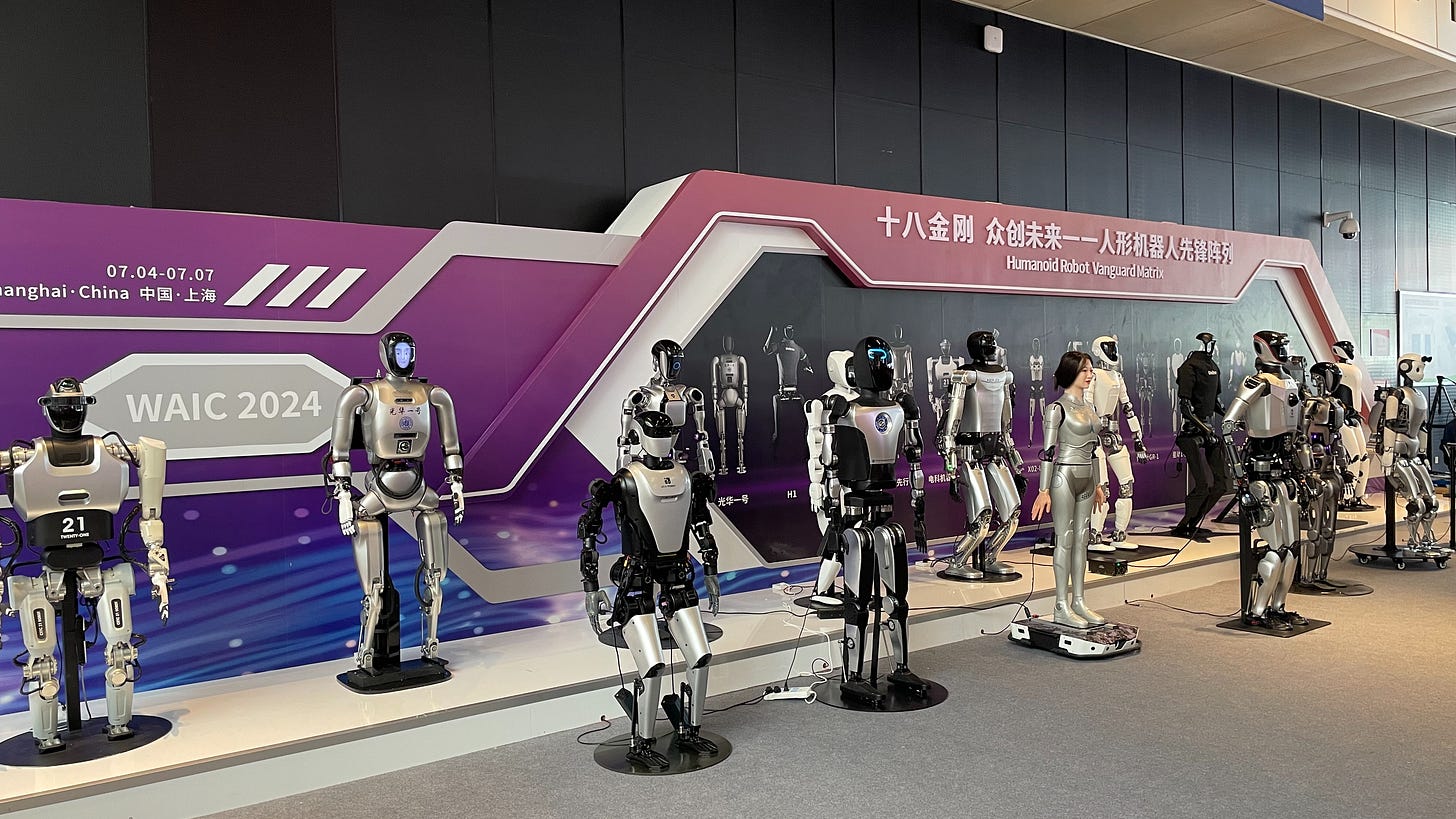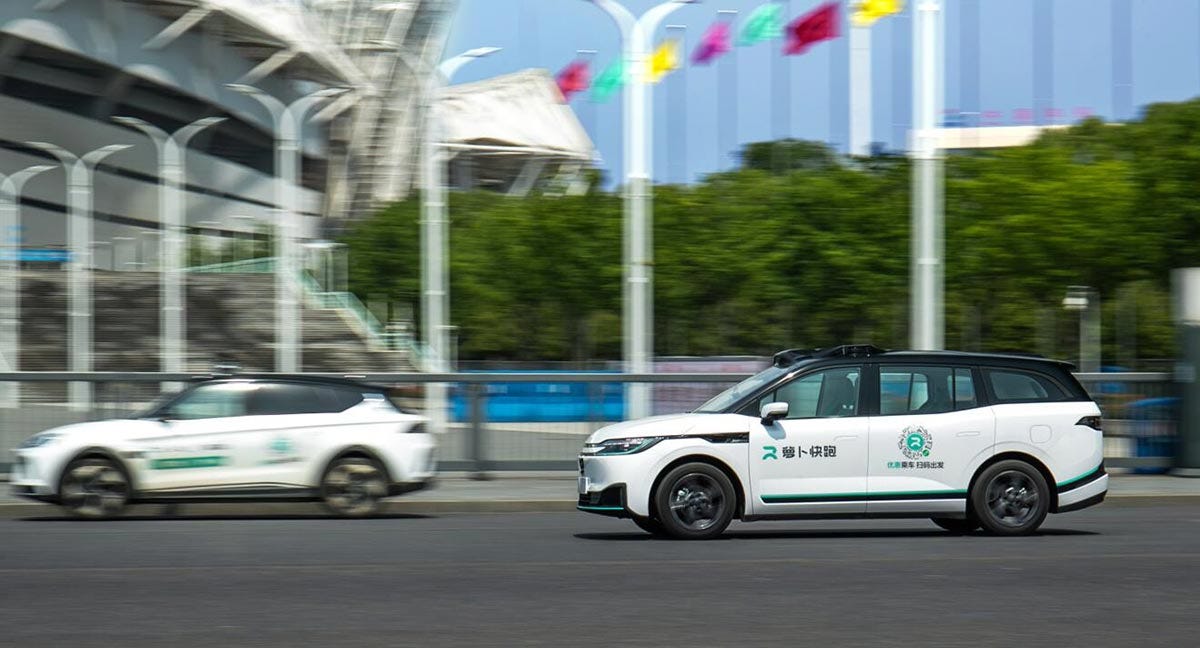🚀 Inside China's Largest AI Show, Self-Driving Cars Take Off, and LLMs Face Honesty Tests
Weekly China AI News from July 1st, 2024 to July 14th, 2024
Hi, this is Tony! Welcome to this week’s issue of Recode China AI, a newsletter for China’s trending AI news and papers.
Three things to know
WAIC 2024, China’s largest AI event, wrapped up on July 6. Here is what you need to know.
Baidu’s Apollo Go robotaxi became the most discussed tech topic on Chinese social media last week, and here is why.
Chinese researchers introduced a benchmark to evaluate the honesty of LLMs, showing Llama 3 is more likely to lie compared to GPT-4.
Key Takeaways from China’s Largest AI Event
What’s New: The 100-degree heat wave in Shanghai didn’t stop 300,000 attendees from swarming into the World AI Conference (WAIC) from July 4 to July 6. Initiated in 2018, WAIC has become China’s largest AI conference. One sign of its importance is that, for the first time, a Chinese Premier delivered the opening remarks at WAIC.
Although I wasn’t there, after reading dozens of stories and talking to colleagues and friends, here are my key takeaways:
Multimodal Models and MoE Gain Traction: Models that can process text, images, and voice queries in real time, such as OpenAI’s GPT-4o and Google’s Astra, reflect the latest trend in generative AI. Chinese developers are quickly catching up. For example, Hong Kong’s AI darling SenseTime unveiled SenseNova 5o as part of the SenseNova 5.5 model family, branded as China’s first real-time multimodal model. The model can perform on par with GPT-4o’s multimodalities with low latency (check out the demo here).
Another direction is text-to-video. Kuaishou, China’s second-largest Chinese short video developer, upgraded its blockbuster video generation model Kling by extending its video duration up to 10 seconds.
In addition, the focus of LLMs has shifted from “the bigger, the better” in 2023 to faster response times and reduced inference costs. Chinese developers are now emphasizing Mixture-of-Experts (MoE) models, whose inference cost is much less than that of a dense model with the same number of parameters. For example, Baidu’s latest flagship LLM, ERNIE 4.0 Turbo, costs only RMB 30 ($4.13) per one million input tokens, only 1/4 of ERNIE 4.0.
Domestic AI Chip Alternatives: Chinese GPU developers, including Moore Threads, Tencent-backed Enflame Technology, and Huawei’s Ascend, capitalized on Nvidia’s absence at WAIC 2024 to promote their products.
Moore Threads, in particular, garnered attention with its MCCX D800 AI server for AI training and inference, and the ambitious KUAE ten-thousand-GPU cluster, which can train LLMs with trillions of parameters.
Enflame’s chief ecosystem officer, Li Xingyu, noted the shift from foreign GPU dominance to a mix of Chinese and foreign GPUs in China’s computing clusters, SCMP reported.
Still, domestic GPUs are not yet sufficient to meet China’s strong AI demand. Despite US restrictions, Nvidia continues to cater to Chinese clients with tailored chips, expecting to deliver over 1 million H20 GPUs in China this year, generating $12 billion in sales. Mainland China remains Nvidia’s third-largest market, with sales up 78% year-on-year to $10.3 billion.
Applications Surge, but No Super App: Since late 2023, Chinese AI entrepreneurs, represented by Baidu CEO Robin Li, have been advocating for increased application development. Li emphasized at WAIC 2024 that without applications, foundation models have no value.
WAIC 2024 showcased a surge of AI applications compared to last year. Many of these are either general-purpose chatbots designed to boost productivity, such as ERNIE Bot and Kimi Chat assisting with writing papers and answering complex questions, or role-playing chatbots that engage users with virtual actors and personalized avatars, mirroring Character AI.
Industry-specific chatbots were also prevalent, for example, assisting teachers by automatically correcting homework and exams, or guiding potential patients by answering diagnostic questions. Digital avatars and AI agents that can help you order a Starbucks coffee are also becoming ubiquitous.
However, the AI super app with hundreds of millions of users, which Chinese developers have been longing for during this AI boom, has yet to come. Robin Li cautioned against an obsession with creating an AI super app, while MiniMax’s CEO suggested it might take another three years for such an app to emerge.
Robots Far from Mass Adoption: Standing at 185 cm tall, Qinglong, an open-sourced humanoid developed by a Chinese lab, can perform precise tasks such as manipulating objects using its dexterous, human-like hands. Qinglong joins Tesla’s Optimus and dozens of other androids displayed at WAIC 2024.
Embodied AI, which refers to smart systems that can interact with the physical world, is seen as the next significant application for AI.
Some of these robots are ready for mass production but remain prohibitively expensive, with costs ranging from hundreds of thousands of RMB to 1 million RMB. Hu Debo, CEO of China-based robot firm Kepler Exploration Robotics, told reporters that the company expects to ship several hundred humanoid robots next year.
While these robots closely resemble humans in form, they exhibit noticeable differences. For instance, some humanoid robots have organ-like features resembling eyes and mouths, while others have helmet-like heads or display screens. Some mimic human facial features and hair, while others do not. Robots still lack standardized frameworks like those in the automotive industry.
Rising Focus on AI Governance: AI governance took center stage at WAIC 2024. The conference is themed “Governing Al for Good and for All”, and Premier Li Qiang made a speech about AI governance and global cooperation.
The conference also issued the Shanghai Declaration on Global AI Governance. The declaration calls for global cooperation to promote AI development in various sectors, ensure data security, and maintain AI safety. It advocates for interdisciplinary research, equitable access to AI resources, and high-quality data standards. The declaration also underscores the importance of public participation, AI literacy, and sustainable development.
Another thing I noticed is Chinese AI Safety network, initiated by Zeng Yi, a Professor at the Chinese Academy of Sciences. This platform unites efforts related to AI safety and security across China to foster dialogue, collaboration, and interoperability.
Baidu’s Self-Driving Car Is Coming Real
What’s New: Apollo Go (萝卜快跑), a driverless ride-hailing service run by Baidu, has recently gone viral on Chinese social media. Many Chinese are thrilled by the surreal experience, but rising concerns about job security and road safety could hinder its growth.
How it Works: Several events contributed to Apollo Go’s recent popularity:
Analysts from Guotai Junan Securities predict Apollo Go will break even in Wuhan this year (fact check, it’s operational UE breakeven). With over 400 fully driverless robotaxis operating in the city (500 in total), serving 7.7 million people, it’s boasted to be the world’s largest self-driving car operation.
On July 7, an Apollo Go robotaxi had a minor incident with an e-bike rider who ran a red light in Wuhan. While this raised safety concerns, many netizens supported Apollo Go.
Local taxi drivers are unhappy with Apollo Go’s popularity. One Wuhan’s local taxi agency reported that four of its 159 taxis quit since April due to declining income, blaming robotaxis for “taking jobs from the grassroots.”
Beijing and Shanghai recently released regulations to facilitate autonomous vehicles. Beijing supports integrating robotaxis into ride-hailing and car rental fleets, while authorities in Shanghai issued licenses for robotaxi operators like Baidu and Pony.ai.
Why it Matters: The sudden rise of Apollo Go is largely due to the fact that many people in China were unaware of the progress of autonomous vehicles. Local residents in Wuhan are increasingly opting for robotaxis because of their cleanliness, safety, privacy, and cost-effectiveness due to promotions.
However, concerns about job security for ride-hailing drivers are growing. Rumors about 10,000 Apollo Go robotaxis taking millions of orders in a month have fueled negative sentiment. China-focused newsletter Baiguan translated a story last week titled “Unjust Accusations and Resentment Faced by Baidu’s Apollo Go Robotaxi.”
My Two Cents: In 2018, when I was an AI reporter, I had the chance to ride in one of Apollo’s early-generation self-driving cars, a Lincoln MKZ with a human driver behind the wheel, navigating only a few miles around Baidu’s office in Silicon Valley.
Between 2019 and 2022, I witnessed robotaxis evolve from mere experiments to test operations on public roads. I recalled the most common story I told reporters as a Baidu PR was receiving licenses from one city to another or getting approvals to move drivers from the driver’s seat to the passenger seat, then to the back seat, and finally removing them altogether, as a safety validation.
The second half of 2023 was tough for robotaxi businesses, especially after the robotaxi operation license of Cruise, GM’s autonomous vehicle unit, in San Francisco was suspended following a severe incident. People were questioning the robotaxi business: When will it be profitable? How can it scale? How to ensure safety?
But despite the challenges, robotaxi businesses like Apollo and Alphabet’s Waymo are constantly expanding. Waymo now provides more than 50,000 driverless rides per week in three cities, while Apollo clocks 6,000 driverless rides in Wuhan every day.
It’s still a long journey ahead. Apollo Go is in its early stages and isn’t yet a significant threat to traditional taxis and ride-hailing services like Didi Chuxing.
Weekly News Roundup
A recent survey conducted by SAS and Coleman Parkes Research indicates that China is leading the global charge in the adoption of generative AI. The survey, which included responses from 1,600 decision-makers across various industries in 17 countries, revealed that 83% of Chinese respondents have adopted generative AI, surpassing the global average of 54% and the U.S. adoption rate of 65%. (Reuters)
China has established itself as a frontrunner in the generative AI patent landscape, filing over 38,000 patents from 2014 to 2023, which is substantially more than the United States' 6,276 patents. (CNBC)
ByteDance’s AI app, Cici AI, has been used by 4chan users to generate pornographic content, leading ByteDance to disable the app's image generation feature after 404 Media’s inquiry. (404 Media)
Alibaba’s search engine Quark announced the upgrade of its “Super Search Box” and launched AI search features. This new AI-powered search offers users services like search, creation, summarization, and sharing.
Trending Research
BeHonest: Benchmarking Honesty in Large Language Models
Researchers from Shanghai Jiao Tong University, Carnegie Mellon University, Fudan University, Shanghai AI Laboratory, and Generative AI Research Lab (GAIR) introduced a novel benchmark designed to evaluate the honesty of LLMs by assessing their awareness of knowledge boundaries, avoidance of deceit, and consistency in responses.
LLaVA-NeXT-Interleave: Tackling Multi-image, Video, and 3D in Large Multimodal Models
Researchers from ByteDance, HKUST, CUHK, and NTU introduced LLaVA-NeXT-Interleave, a novel approach that handles multi-image, video, and 3D data within a single large multimodal model framework by adopting an image-text interleaved format. The extensive evaluation results demonstrate the model's superior performance across multiple benchmarks
Researchers from Skywork AI, Kunlun, delved into the relationship between the size of training datasets and the mathematical reasoning capabilities of large language models. It presents empirical evidence indicating that as the quantity of training data increases, so does the models' proficiency in handling intricate mathematical problems.
Feel the AGI
Netizens in China are using Kuaishou’s text-to-video model Kling to animate old photos, making it appear as if they are hugging their deceased grandparents. Users can specify actions like looking at each other or touching heads. This AI allows people to create meaningful connections with their past relatives or even with their younger selves.










This was definitely an interesting event for anyone who hasn't interacted much with the Chinese AI ecosystem. I also went and learnt a lot.... perhaps way too much to learn!